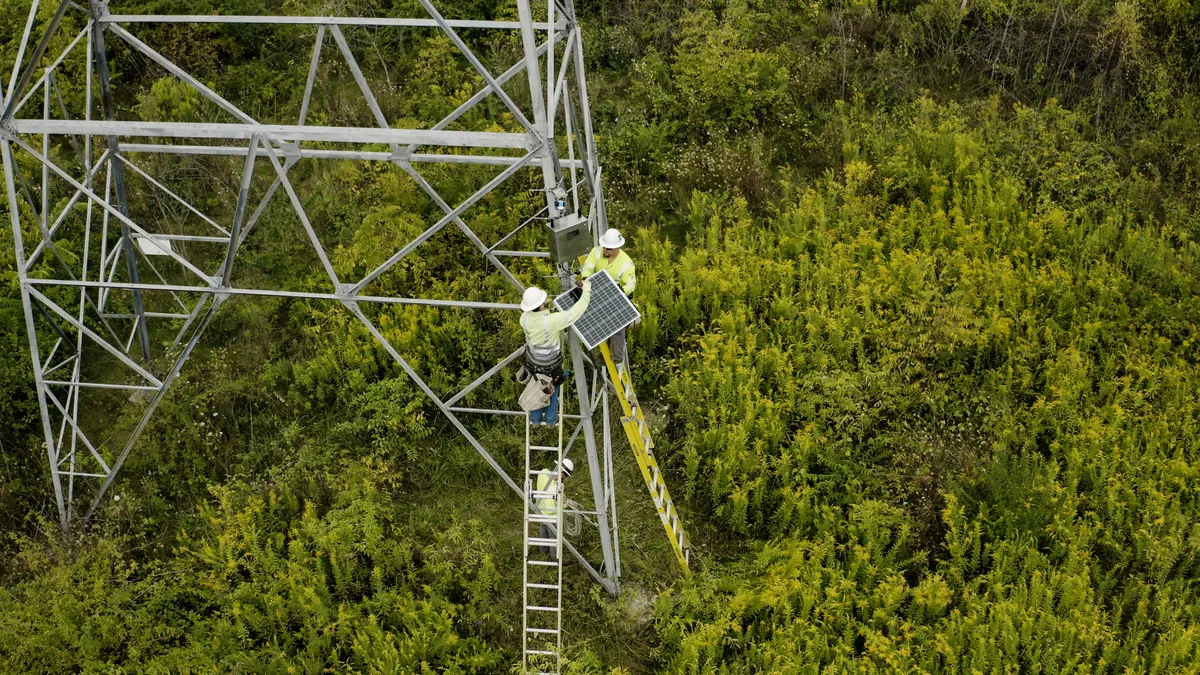Dive Brief:
-
Grid-enhancing technologies, called GETs, could help bring 6.6 GW of clean energy online in five PJM Interconnection states by 2027 at a sharply lower cost compared to standard network upgrades, according to a study released Thursday by RMI.
-
The GETs needed to support the wind, solar and energy storage would cost about $100 million while producing about $1 billion in annual production cost savings across PJM’s footprint, RMI said in the report, GETting Interconnected in PJM.
-
PJM should incorporate GETs evaluations into its grid interconnection and transmission planning processes, according to RMI, a non-profit group focused on reducing carbon emissions. “GETs are applicable in a planning paradigm,” Sarah Toth, an RMI senior associate and one of the report’s authors, said in an interview. “They result in reliable outcomes. They're cost effective, and they can help new generation get online faster.”
Dive Insight:
GETs — such as dynamic line ratings, or DLRs, advanced power flow controls and topology optimization — can be used to increase the capacity of the existing transmission system, providing a relatively quick, low-cost pathway for bringing new generation online.
With PJM, the North American Electric Reliability Corp. and others concerned that power plant retirements may be outpacing new generation additions, GETs are seen as an option for bringing new generation online to help maintain grid reliability.
RMI worked with Quanta Technology to explore the use of GETs to bring 126 GW of pending generation and storage resources online in Illinois, Indiana, Ohio, Pennsylvania, and Virginia. Quanta developed a power flow model to assess how projects in PJM’s interconnection queue would affect the grid. After removing projects from the model that didn’t appear viable, Quanta assessed whether GETs could be used to handle transmission overloads created by the remaining planned projects.
Among other things, the modeling found that DLRs, which measure a transmission line’s capacity in real-time, could boost the summertime ratings of power lines by 17% on average compared to static ratings. Under the modeling, DLR was applied to 49 transmission overloads across the five-state study footprint, facilitating the integration of 5.2 GW of interconnecting generation.
As an example of the benefits of using GETs, RMI cited a 106-MW wind farm project by an Algonquin Power & Utilities subsidiary in Commonwealth Edison’s service territory in Illinois. PJM determined the Shady Oaks Wind 2 project would require about $100 million of system upgrades.
Ultimately, PJM approved the use of Smart Wires’ power flow control devices for the project, which reduced interconnection costs to $12 million and cut interconnection time to about 15 months from three years, according to the report.
RMI recommended that when PJM revamps its generator interconnection process rules to comply with FERC Order 2023, issued in July, the grid operator include GETs in its interconnection study process.
Also, transmission owners should launch inaugural GETs projects to become familiar with the technology, according to RMI.
PPL Electric was the first U.S. utility to install real-time operational DLR, according to a Feb. 9 filing at FERC on the agency’s inquiry into DLRs. The DLR technology, which went online in October 2022 in Pennsylvania, reduced congestion costs on one transmission line from about $66 million in the 2021–2022 winter to about $1.6 million the following winter, according to PPL Electric. The DLRs increased the “normal” line ratings on the three lines by about 17% compared to their ambient adjusted line ratings, the utility said.
The DLRs also helped PJM provide power during Winter Storm Elliott, the grid operator told FERC in a January filing. PJM said it supports the “transparent, cost effective, efficient and reliable deployment of DLR.”
PPL Electric plans to install DLR technology on five more transmission lines by July and its sister utility Rhode Island Energy also intends to adopt DLRs on its system, according to the Allentown, Pennsylvania-based utility.
“The value of DLRs in certain use cases has now been conclusively demonstrated and it is appropriate to expand their use on the transmission system,” PPL Electric said.
PPL Electric said it supports PJM’s proposal that transmission providers develop methodologies to evaluate historical and future congestion on the transmission system, which would help transmission owners and PJM better evaluate where DLR would bring the greatest benefits to the grid.
“Although DLRs cannot be reliably used for reliability violations, as they cannot guarantee higher ratings in peak cases, they remain an important tool that should be encouraged,” PPL Electric said.
Among its recommendations, RMI urged state utility regulators to use performance incentive mechanisms that reward utilities for installing GETs, or allow utilities to share in the ratepayer cost savings from using the technology.














